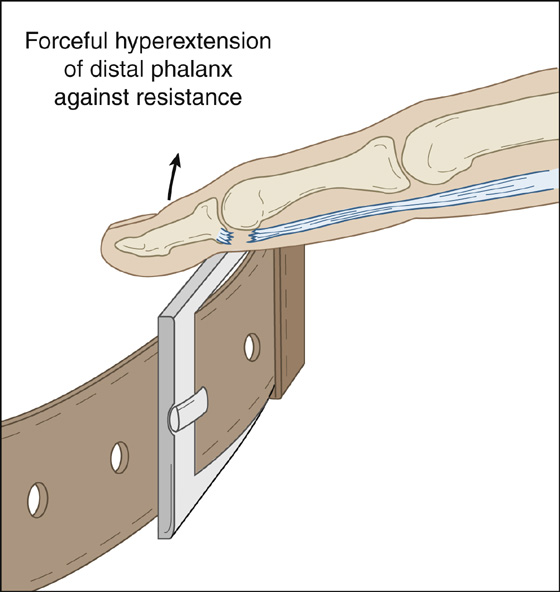CHAPTER 112
Flexor Digitorum Profundus Tendon Avulsion—Distal Phalanx
(Splay Finger)
Presentation
The patient has injured his finger tip by falling backward and striking it on the floor or hitting it in some other way, causing sudden and forceful hyperextension at the distal interphalangeal (DIP) joint against resistance. Alternatively, this injury can befall a football player trying to tackle the ball carrier but only catching the jersey or belt with the distal phalanx of one finger (Figure 112-1). Both mechanisms can avulse the insertion of the flexor tendon on the distal phalanx. The patient may feel a pop, followed by immediate pain and swelling. The distal fingerpad becomes markedly swollen, often with ecchymosis. The patient is often unaware that he cannot flex the DIP joint.

Figure 112-1 Avulsion of the flexor digitorum profundus tendon.
What To Do:
 Have the patient try to close the fingers against the palm in a loose fist. All the fingers will readily flex into the palm, but the DIP joint of the injured digit is unable to bend, and the patient cannot bring the finger tip into the palm. The patient will have full range of motion of the proximal interphalangeal joint.
Have the patient try to close the fingers against the palm in a loose fist. All the fingers will readily flex into the palm, but the DIP joint of the injured digit is unable to bend, and the patient cannot bring the finger tip into the palm. The patient will have full range of motion of the proximal interphalangeal joint.
 Neurovascular examination reveals intact function.
Neurovascular examination reveals intact function.
 Obtain radiographs of the finger with anteroposterior and lateral views. The radiograph is usually normal, although occasionally a small avulsion fracture may be visible on the proximal volar aspect of the distal phalanx.
Obtain radiographs of the finger with anteroposterior and lateral views. The radiograph is usually normal, although occasionally a small avulsion fracture may be visible on the proximal volar aspect of the distal phalanx.
 Request consultation from a hand surgeon for early surgical repair. If this injury is not treated within 3 weeks, the tendon will shorten and retract into the palm.
Request consultation from a hand surgeon for early surgical repair. If this injury is not treated within 3 weeks, the tendon will shorten and retract into the palm.
 A protective dorsal splint (positioned for greatest comfort) incorporating the adjacent finger and extending to the mid-forearm can be applied to reduce pain and help prevent further injury.
A protective dorsal splint (positioned for greatest comfort) incorporating the adjacent finger and extending to the mid-forearm can be applied to reduce pain and help prevent further injury.
 Provide necessary analgesia with nonsteroidal anti-inflammatory drugs (NSAIDs) or acetaminophen.
Provide necessary analgesia with nonsteroidal anti-inflammatory drugs (NSAIDs) or acetaminophen.
What Not To Do:
 Do not assume a simple sprain exists because of negative radiographs. When there is marked swelling of the distal finger pad following a grabbing injury, be mindful of the possibility of a flexor digitorum profundus avulsion.
Do not assume a simple sprain exists because of negative radiographs. When there is marked swelling of the distal finger pad following a grabbing injury, be mindful of the possibility of a flexor digitorum profundus avulsion.
Avulsion of the insertion of the flexor digitorum profundus tendon results from the sudden forced extension of a finger during resisted flexion of the digit with the metacarpophalangeal joint in extension. Unless the clinician specifically examines for active flexion of the DIP joint, the opportunity to repair the tendinous insertion may be lost.
Stay updated, free articles. Join our Telegram channel

Full access? Get Clinical Tree


